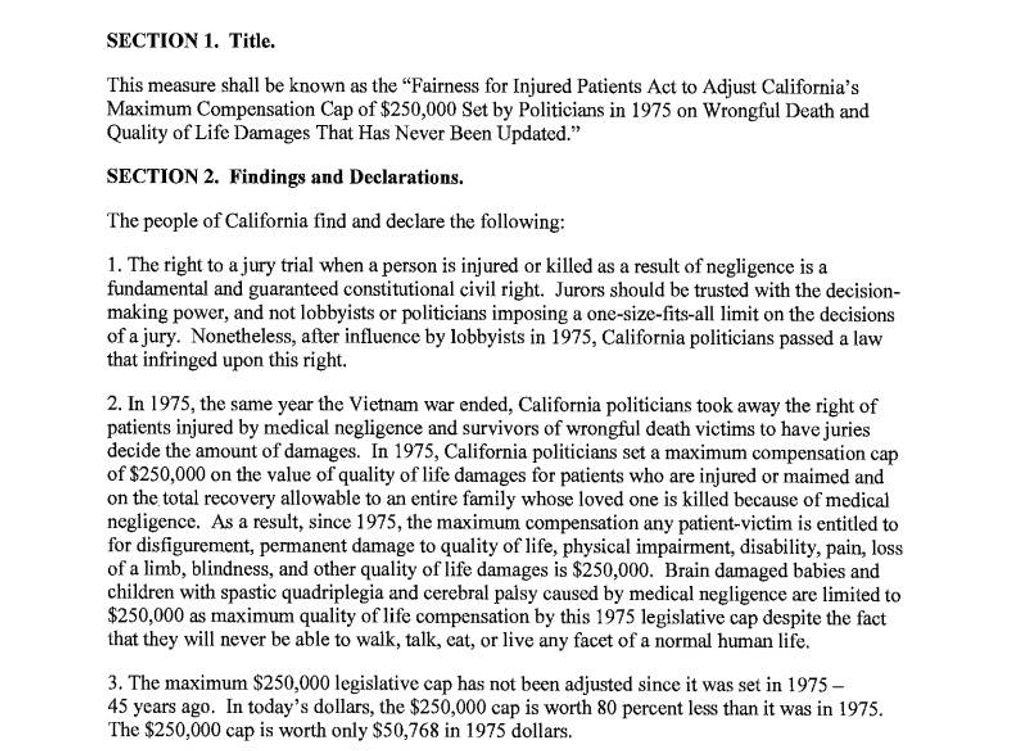
Understanding the Fairness for Injured Patients Act
 By Daniel Amos
By Daniel Amos This is the third article in a series about important ballot initiatives coming in November 2022 that may have a significant impact on consumers. Our first two articles were about the Consumer Legal Fee Protection Act and the Pre-Lawsuit Notice and Opportunity to Settle Act. This article is about the Fairness for Injured Patients Act.
What is the "Fairness for Injured Patients Act"?
The Fairness for Injured Patients Act increases the amount a victim of medical malpractice could potentially receive in a lawsuit. Most people in California don’t realize that since 1975 the amount of compensation a person who files a medical malpractice case can recover for general damages is limited to just $250,000. That amount was set in 1975 and has never been raised.
The $250,000 cap applies to all injury and death medical malpractice cases no matter how terrible or debilitating the injury. In other words, if your child is killed by the negligence of a doctor, all you can recover for your child's death is $250,000, that’s it. That’s all your child’s life is worth under this archaic and unfair law. The Fairness for Injured Patients Act would simply adjust the cap for inflation. In today’s dollars, the $250,000 cap, which was set back in 1975, is only worth about $50,000.
This unfortunate 1975 law is known as the Medical Injury Compensation Reform Act of 1975 or MICRA, and if you have never been involved in a medical malpractice case, you have probably never heard of it.

Who is in favor of the Fairness for Injured Patients Act?
The Fairness for Injured Patients Act is supported by the Fairness for Injured Patients Act Coalition and Consumer Watchdog which writes: ““It’s time for voters to get a chance to change this unjust 45-year-old law and give injured patients and their families a chance to hold the medical insurance complex accountable for its negligence and malfeasance,” said Scott Olsen, a survivor of medical negligence and proponent of the measure, who is a board member of Consumer Watchdog. Olsen’s son Steven was only two years old when he was rendered blind and brain-damaged due to medical negligence. Twenty-three years ago, a California judge was forced to reduce the jury's $7 million verdict for Steven's lost sight, brain function, and independence to California's $250,000 cap. Steven is 30 years old today and requires full-time care and supervision.”
The ballot initiative has also been recently supported by former California Insurance Commissioner Steve Poizner who wrote: “This is a common sense and modest adjustment to a law that is terribly outdated and keeps California behind the times, rather than being a leader in patient care and medical accountability. ...There’s still time for Sacramento politicians to step up and fix this mistake. But if not, it will be up to California voters next November to correct this long overdue injustice.”
Also,” Almost every major newspaper editorial board in California over the last decade has come out in favor of changing the half-a-century old law, the Medical Injury Compensation Reform Act of 1975 (MICRA), as have many prominent politicians.”
Here is a fact sheet with some astonishing facts about the MICRA law which has been on the books in California since 1975 which shows how dangerous and out of step California is with the rest of the country: FACT SHEET
And here are some short videos about real-life victims of this archaic law: Stories of Real People

Who is against the Fairness for Injured Patients Act?
The Fairness for Injured Patients Act is opposed by the medical industry and their insurance companies, including the Medical Insurance Exchange of California, The Doctors Company, Kaiser Foundation Health Plan, Inc. and the California Medical Association. They claim in part that, “This measure will raise insurance costs, causing physicians in high-risk specialties like OB/GYNs to reduce or eliminate patient services.” CMA They claim, “This measure was written by an out-of-state trial attorney who is looking to cash in with California cases. This ballot measure is simply a cynical effort by a single trial lawyer looking to increase lawyers’ share of medical malpractice awards and line his own pockets while driving up health care costs for all Californians.”
The medical industry in the United States is one of the most powerful and wealthy industries in the world. According to Policy Advice, "In 2018, this sector was worth $8.45 trillion, with an annual growth rate of 7.3% since 2014. It's expected that the healthcare industry will continue to grow. In the US alone, the market size will increase by $808 billion by 2021, according to the latest estimates."
The argument that this adjustment of the MICRA laws will harm the healthcare industry is absurd. If the amount of $250,000 was a "fair recovery" back in 1975, then adjusting that figure to meet today's dollars is the least we can do for victims of medical malpractice.
What does the official summary of the Fairness for Injured Patients Act state?
The summary of the Fairness for Injured Patients Act provided for inclusion on signature petition sheets is as follows:
- "In medical negligence cases, adjusts for inflation: (1) $250,000 limit established in 1975 on quality-of-life and survivor damages (which include pain and suffering); and (2) contingent attorney’s fees limits established in 1987. In cases involving death or permanent injury, allows judge or jury to exceed these limits and requires judge to award attorney’s fees. Requires attorneys filing medical negligence cases to certify reasonable basis for claims or good faith attempt to obtain medical opinion; attorneys who file meritless lawsuits must pay defendant’s expenses. Extends deadlines for filing medical negligence lawsuits."

The deck is stacked against victims of medical malpractice
I was looking forward to reviewing this ballot initiative because it strikes home with me. During my 25 years as a practicing lawyer, I represented families who were victims of medical malpractice. I reviewed thousands of medical malpractice cases, but very few of them could ever be filed in court because they are incredibly expensive for patients and their lawyers to litigate, the amount lawyers who represent patients can recover is severely restricted, the amount patients can recover is restricted, and the rules in malpractice cases heavily favor doctors and hospitals. In short, the deck is stacked against the victims of medical malpractice in so many ways.
Since 2009 I have been running Higher Legal, a California State Bar Certified Lawyer Referral Service (LRS#130) and I receive many calls from people who are hoping to find a lawyer to take their medical malpractice case. Unfortunately, I am able to place probably 1% of them with a medical malpractice lawyer. It is very hard to find lawyers who will take medical malpractice cases because the deck is stacked against the victims. Here’s what I mean.
Lawyers who take medical malpractice cases are paid on a contingency fee basis. (see my article on contingency fee contracts) That means the lawyer has to pay all the costs out of their own pocket (usually tens of thousands of dollars) and they work basically for free until there is a recovery in the case (which can take years), and if there is no recovery, they don’t get paid for any of the hard work they did for all those years, and they lose the tens of thousands of dollars they personally invested in the case. In other words, there is a tremendous financial risk in taking a medical malpractice case.
Because of the high risk in taking a medical malpractice case, the lawyers who review these cases are really careful about what cases they take because there's so much risk involved.
And the deck is further stacked against victims of medical malpractice because the lawyers who represent the doctors and hospitals and their insurance companies in medical malpractice cases get paid no matter what happens in the case. They have no risk, they always get paid, win or lose, often tens of thousands of dollars or more. And they don’t have to pay any of the costs out of their own pocket. In other words, it's not a level playing field. The cards are all stacked against the victim of medical malpractice and in favor of the doctors, hospitals and their insurance companies, and their teams of lawyers.

A personal story
Let me give you just one example from personal experience. I won’t use any real names or pictures to protect confidentiality.
I had a medical malpractice case against a hospital that involved a young man who went into the hospital complaining of “the worst headache of his life”. That's a classic presentation of someone with a head bleed. He couldn't think of anything that might have caused his headache. He didn’t have any head trauma, no allergic reactions, no drugs, nothing at all. It just suddenly came on.
In fact, this young man was very health conscious and took excellent care of himself. He ate organic, he worked out, he did meditation and all the things we are told to do for good health. And he was concerned when this horrible headache suddenly came on.
But unfortunately for him, the doctor at the emergency room apparently didn’t like the way he looked or the way he dressed because he had dreadlock hair and wore Rastafarian clothing. The doctor sent him home without doing any diagnostic testing and assumed he was on drugs but wasn’t disclosing that information. The young man went home and slept for several hours and then came back to the same emergency room because his headache was 10x worse and he was now having trouble seeing, especially in the light. Once again the doctor failed to do any testing and sent him home.
Approximately 24 hours later my client had a massive head bleed and suffered irreversible brain damage. He went from a strong, athletic, and healthy young man who was independent and had a bright future, to someone who was now unable to feed himself, unable to provide basic hygiene for himself, and unable to walk or talk. He needed full-time care and was forced to move home into his parent's house so they could take care of him for the rest of his life.
I was asked by his parents if there was a medical malpractice case, and clearly, there was. In fact, the case was so strong that I was able to get a doctor from the same entity as the emergency room doctor that repeatedly sent him home, to testify on my client's behalf.
But despite how strong the case was, the doctor and the hospital, and their insurance company refused to offer anything to settle the case. It went on for years and finally after many years of costly and contentious litigation, it went to a court trial we won the case. And guess what: Despite the fact that this young man’s life had been destroyed, under this 1975 law, he could only recover $250,000 for his lifetime of pain and suffering.
That is simply unfair.

Why would anyone be against the Fairness for Injured Patients Act?
I have said this before and I’ll say it again. It all boils down to money. The insurance companies and medical lobbies have all the money and they don’t want to give any of it up.
In practically every type of personal injury lawsuit you can think of, car accidents, trip and falls, defective toys that harm or kill children, toxic exposure, dog bite attacks, exploding defective products, etc. - in all of these cases we allow a jury of our peers to hear the evidence and decide if there is a valid case or not, and if there is, then to decide how much money the injured person deserves. The only type of case that is different is the medical malpractice case. The only ones who play by a different set of rules are the doctors, hospitals, and most importantly their insurance companies who spent a fortune back in 1975 to enact this terribly unfair law.
The logic behind the 1975 MICRA “cap on damages” is ridiculous
On its face, some people might agree with some of the arguments the medical insurance lobby tries to make such as, “This measure would have a particularly adverse impact on community health clinics” or “This measure will raise insurance costs, causing physicians in high-risk specialties like OB/GYNs to reduce or eliminate patient services.” There is simply no evidence to support these claims.
And what's worse, using their logic, if we put a "cap" on everything at the rate it was in 1975, here is what (according to their logic) we should pay for a few other items at 1975 prices:
- The cost of a McDonald’s hamburger should be .25 cents
- A gallon of gas should be .57 cents a gallon
- The average cost of a home in the US should be $42,000
I could go on and on with these, but I think you get the point and the absurdity of this MICRA law. It is idiotic and un-American.
Don't be brainwashed by the medical industry
As I mentioned, during my 25 years of practicing law I reviewed thousands of potential medical malpractice cases and I accepted and filed very few of them. I was always astonished when potential clients were surprised that I could not accept their case. They thought that lawyers took every case. They thought there were thousands of medical malpractice cases. That's because the medical industry has done a great job brainwashing the public into thinking that "there are so many lawsuits against doctors". That is simply not true.
I have even spoken with doctors who are going through their medical residency who have said during the first weeks of their training are required to meet with the lawyers of the hospital and the medical insurance company where they are told they have to be careful because they are going to get sued by patients all the time. That is simply not true. In fact, some of these doctors have reported that not only have they never been sued, and never heard of anyone else at their hospital being sued, they have observed actions by doctors which could very well constitute medical negligence but even those actions never amounted to a medical malpractice case.
Our society has unfortunately been conditioned over many years and by billions of dollars spent by the medical industry to make us believe that lawyers who represent victims of medical malpractice are the bad guys. That is absolutely false. Don't let the medical industry brainwash you.
What questions do you have about the Fairness for Injured Patients Act?
My hope at Higher Legal is to provide you with as much information about this and other November ballot initiatives as possible. I would also like to hear what questions you have so please send me your questions at Higher Legal.
Higher Legal is your source for in-depth legal information. Higher Legal will have updates on this story and news stories about the ballot initiatives in the months ahead. Please subscribe to this blog and to the Higher Legal YouTube channel to stay up to date.
Thanks for reading!